Understanding Zebra Finch Bird Cages: A Complete Guide

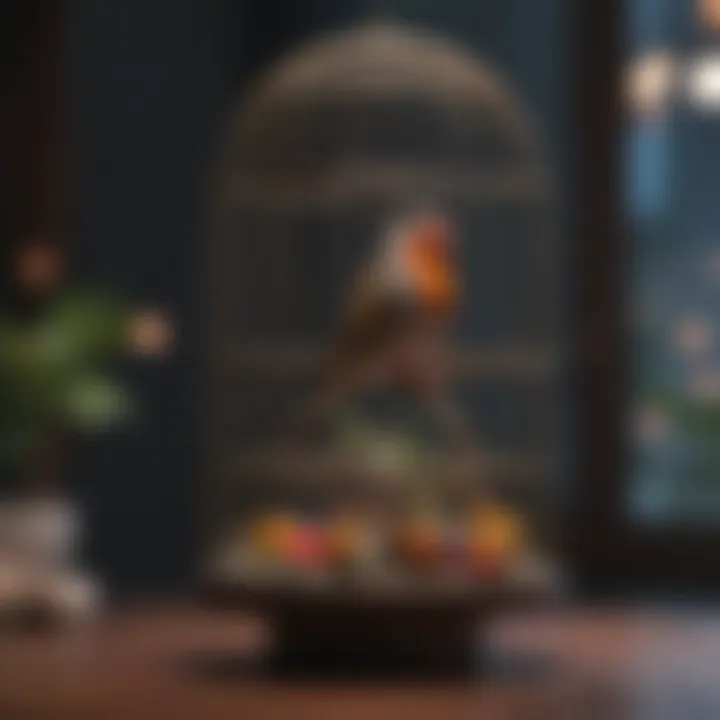
Intro
Zebra finches are fascinating creatures known for their lively personalities and beautiful plumage. These small birds, native to Australia, thrive in social environments, making them ideal pets for bird enthusiasts. Opting for a suitable cage is crucial in providing these birds with an optimal habitat. The choice of cage impacts their health, behavior, and overall happiness.
Choosing a bird cage carefully is key. Important factors should be considered, such as size, shape, and interior arrangement. Additionally, daily care practices play a significant role in their well-being. Understanding these aspects ensures that zebra finches can flourish in a safe and enriching environment. In this guide, we will explore careful considerations, maintenance tips, enrichment strategies, and more, creating a comprehensive resource for current and prospective zebra finch owners.
Care Tips
Daily Care Routines
Caring for zebra finches involves consistent daily routines. Starting each day with observation is important. This practice helps you understand their needs and moods. Providing them food and fresh water should be a priority.
You might notice that your zebra finches tend to prefer certain foods or areas in their cage. Make sure you offer a balance of seeds, fruits, and vegetables to cater for their dietary needs. Remember, their food and water bowls need to be cleaned daily to aclimming dirt or germs.
Cage Setup and Maintenance
The cage setup must be spacious enough for zebra finches to move comfortably. A cage width of 24 inches and height of 30 inches is generally suitable for a small group. Bars should be horizontal, typically spaced about half-an-inch apart. This design allows zebra finches to climb, which is natural and beneficial for their exercise.
Regular maintenance involves checking for any loose or damage parts of the avairy. Ensure the perches are positioned at various height levels. These adjustments encourage natural behaviors like flight and hopping.
Hygiene and Cleaning Practices
Maintaining hygiene is crucial for bird health. Recent studies recommend thorough cleaning of the cage every week. This involves removing waste, changing bedding, and sanitizing food and water containers. Effective disinfection reduces the chances of bacterial infection.
Seasonal Care Adjustments
With changes in season, adaptations must be made in your zebra finch care routine. This could mean adjusting indoor temperature, especially during winter. Providing different types of feeding options during different seasons ensures that your birds get the necessary nutrients required during various climat challenges.
E.g., during summer months, they may prefer lighter foods, while rich treats are proper for other seasons.
Behavioral Insights
Understanding Bird Body Language
Observing zebra finches enables owners to recognize subtle body language cues. For example, elevated wings signify excitement while lowered wings denote discomfort. Learning these signs fosters a stronger human-bird relationship.
Common Behavioral Issues and Solutions
Identifying behavioral issues may help you address underlying problems. Birds often chew on feathers and demonstrate aggression under stress. Assess cage environment, interactions, and dietary components to tackle these problems effectively.
Positive Reinforcement Techniques
Training your zebra finch can be accomplished easily with positive reinforcement methods. For instance, rewards for achieving small tasks promote confidence and companionship. Incorporating this learning into daily routines results in a stronger bond.
Social Interaction Needs
Zebra finches flourish in social settings. It's generally recommended to keep them in pairs or small groups. This social structure encourages natural behaviors while preventing loneliness, a commonly reported issue in individual captive birds.
Nutrition Guides
Essential Diet Components
Zebra finches need a varied diet, which mainly consists of seeds, grains, and greens. A premium quality seed mix like that from Hartz or Wagner is beneficial. Fresh produce completes their diet further, especially leafy greens.
Safe and Toxic Foods
Recognizing which foods are safe or toxic is vital. As a rule of thumb, avoid feeding avocados, chocolate, or alcohol, as they can be toxic.
Supplements and Treats
Occasional supplements, such as cuttlebone, provides calcium essential for bone growth. Additionally, introducing rewards can motivate healthy exploratory behavior.
Feeding Strategies for Different Groups
If owning multiple species, be aware that zebras have specific dietary needs. They consume providing a balanced dollop equally is important. Cohabiting finches of diverse species need considerations as they maybe showing preference conflicts.
Wellness and Health
Routine Health Checkups


Frequent checkup visits with an avian vet are critical. Keeping a record of weight, plumage quality, and general behavior allows one to recognize possible health concerns early.
Identifying Symptoms of Illness
Key symptoms such as lethargy, feather plucking, and noisy breathing indicate possible disorders. Regularly observe your finch for timely intervention.
Preventative Care and Vaccinations
Appropriate vaccines should be discussed with your veterinarian, ensuring protection against common diseases in zebra finches. Routine cleaning practices further act as disease prevention.
Mental and Emotional Well-being
Consider activities encouraging mental stimulation. Variety keeps behaviors well within healthy domains by maintaining interest and curiosity about surroundings.
Enriching Activities
Toys and Playtime Ideas
Provide a variety of toys such as chewables, bells, and mirrors to encourage interaction. Different textures promote investigation and curiosity from your finch.
Training and Tricks
Simple tricks such as target oppos and perch rotation encourage cognitive engagement. Establish a routine to gradually considerable bond over repetitions over time.
Outdoor Activities and Interaction
Supervised outdoor time promotes exercise. Providing aviaries or bird-safe enclosures extends beneficial fresh air access without danger.
DIY Projects for Mental Stimulation
Creating unique enchantments within the cage supports stimulation and creates an enriching environment. Examples include bird-safe shelves for climbing or chewable items attached using jute twine.
It’s essential for zebra finch owners to engage regularly with their birds. Each interaction strengthens not just the bond, but also the mental health of these small creatures.
Intro to Zebra Finches
Understanding zebra finches is crucial for any aspiring bird owner. These small birds are not only charming pets but also engaging companions. They possess unique behaviors and social structures that are worthy of appreciation. Gaining insight into their temperament can enhance interactions with them. Mile upon mile of natural habitat in Australia, where zebra finches originate, gives these birds special needs. This knowledge forms the foundation for providing optimal care.
Zebra finches are particularly renowned for their beautiful plumage and melodious songs. Observing them and interpreting their behavior becomes delightful when you become familiar with their needs and characteristics. As social creatures, they thrive when they are in pairs or groups. Hence, this social structure influences the type of environment necessary for their well-being.
Understanding Zebra Finches
Zebra finches, Taeniopygia guttata, are small finch birds measuring about 4.7 to 5.5 inches in length. Their most distinguishing feature is the vibrant coloration, influenced by genetics. The males often have bright orange cheek patches and stripes, while females typically exhibit more muted tones. This dull coloration is a result of natural selection to camouflage when nesting. Their delightful chirps are another enjoyable aspect of having them as pets. Recognizing their calls helps in understanding their moods and social dynamics.
Care requirements for zebra finches span diet, housing, and social needs. A diet consisting of quality seed mixes, vegetables, and mineral supplements is essential. Specific to housing, cages must promote healthy behaviors and comfort. Outfitting the cage with appropriate enrichments is a no less vital aspect of care.
Significance of Cage Selection
The selection of a suitable cage significantly impacts the mental and physical health of zebra finches. This process requires careful consideration of various factors. The cage must provide adequate space for exercise, with dimensions that facilitate movement. Narrow spaces may lead to stress, affecting the birds' overall demeanor.
Awell-ventilated cage reduces the risk of respiratory issues. Appropriate materials can ensure durability while minimizing hazards. It also helps avoid frustration that could result from an enclosure that is too cramped or improperly designed.
Overall, cage selection can affect the finches' nesting behaviors too. Many times, it influences whether they feel secure. Appropriate types of environments encourage natural instincts.
It is essential to note that providing a suitable cage not only promotes well-being but also ensures the conservation of their social behavior and physical health.
Potential cage owners must consider these factors deeply. Comprehending the zebra finch dynamic allows for improved care and enhances the bonding experience.
Essential Cage Characteristics
Choosing the right characteristics for a zebra finch cage ensures the health and happiness of these lively birds. Fundamental aspects to consider include size, materials, and safety features. Each characteristic not only affects the birds’ well-being but also influences their interactions with the environment and each other.
Size Requirements
The size of a cage is paramount for zebra finches. They require space to move and engage in natural behaviors such as flying, hopping, and exploring. Inadequate space can lead to stress and behavioral issues.
Minimum cage dimensions for two zebra finches should be at least 30 inches long, 18 inches wide, and 18 inches tall. Larger cages are always preferable; this allows the birds more freedom and the ability to interact played more. Cage height is essential too, as zebra finches enjoy perching at various levels.
An unrestricted environment helps mitigate aggression and promote a sense of security. Incorporate vertical space with perches and toys to create an engaging habitat. Think of ways you can modify the environment often to maintain interest.
Cage Material Considerations
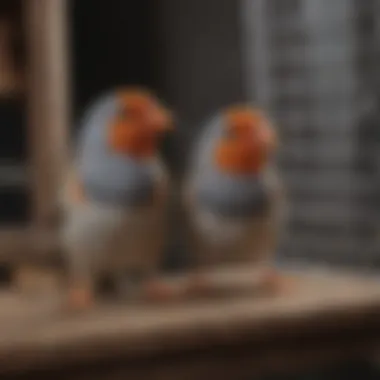
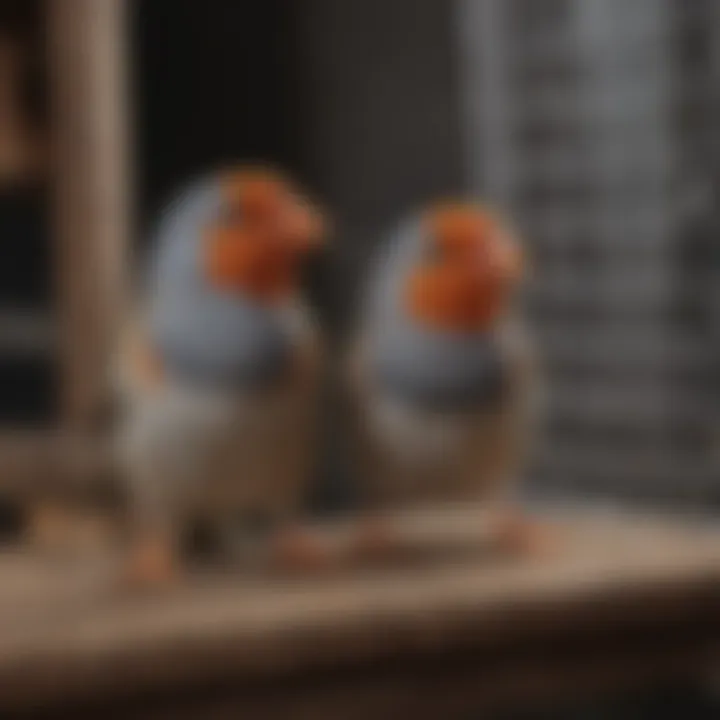
Materials contribute significantly to both safety and longevity. The structure should be made of non-toxic materials. Most cages use metal or plastic, and each has its pros and cons.
Metal cages, typically from wrought iron or stainless steel, are sturdy and easy to clean. However, care must be taken to avoid cages with toxic coatings. Paints and galvanizing materials can be unsafe and lead to health issues.
Plastic cages, though lighter, can be prone to wear and tear. They may not be suitable for long-term use, especially if multiple birds are housed together. Look for products specifically marked as bird-safe. It’s crucial to invest in a high-quality cage that ensures the safety of your finches.
Bar Spacing and Safety
Bar spacing is essential for the safety of your zebra finches. If the bars are too far apart, the birds may squeeze through or get stuck, leading to potential injuries or escapes.
Optimal spacing should be no more than 0.5 inches. This detail allows for safe confinement while still providing a comfortable viewing space.
Additionally, ensure all corners are rounded and no sharp edges or protruding parts are present. It’s also a good idea to regularly check the cage, as wear can result in potentially hazardous conditions.
Remember: Safety and comfort are the two largest concerns with cage selection. Pay attention to the characteristics to enhance the welfare of your zebra finches.
Types of Cages for Zebra Finches
The selection of an appropriate cage is paramount for the well-being of zebra finches. A properly designed cage can provide a secure and enriching environment, ensuring the birds remain healthy and engaged. Different types of cages serve various purposes and needs depending on your specific circumstances and the shared life space you intend to create for your finches.
Flight Cages
Flight cages are designed to provide zebra finches ample space for movement and exercise. These cages are generally larger, characterized by a height that allows the birds to flapping their wings without restriction. The spaciousness allows finches to engage in their natural behaviors which include flying, hopping, and exploring.
Benefits:
- Exercise Opportunities: Unlike smaller cages, flight cages mimic more of their natural habitat, promoting physical activity. This plays a notable role in keeping your birds healthy.
- Social Interaction: With more space, finches that live in pairs or groups benefit significantly. They can socialize without feeling confined.
- Flexible Setup: The larger area gives room to include more toys and perches that can be arranged for an enriched living condition.
Play Cages
Play cages differ from general housing as they are meant for interaction outside of the traditional living space. These cages are often portable, facilitating easy movement. They can be utilized during supervised free time so that zebra finches can explore and play in a safe area.
Considerations:
- Creative Exploration: It allows owners to engage their finches with various activities away from their main cage, which can be important for mental stimulation.
- Ease of Use: Play cages should be easy to transport and construct, making it simpler to integrate playtime into your daily routine.
- Safe Design: The design must ensure it is safe, preventing the birds from escaping during supervised play.
Breeding Cages
Breeding cages are specialized cages tailored towards the reproduction of zebra finches. They are usually smaller than flight cages but offer multiple compartments to encourage nesting behaviors. The setup will need to take into account a somewhat quieter environment to promote breeding.
Important Features:
- Separate Sections: This design allows for individual pairs to be sectioned off. This is crucial to safeguard both the parent birds and the eggs or chicks from other birds.
- Nesting Areas: Provide proper nesting materials and dedicated spaces where the birds can safely tend to their young.
- Ventilation and Safety: Special attention should be placed on proper air circulation and safety features since they are crucial to the health of both the breeding pairs and their offspring.
Choosing the right cage type is an essential step to ensure zebra finches thrive and exhibit their natural behaviors.
Expanding upon the uniqueness of these cages allows bird owners to appreciate not just aesthetics, but how each choice plays an imperative role in fostering healthy, happy zebra finches.
Cage Accessories and Enrichment
Cage accessories and enrichment are crucial for the overall welfare of zebra finches. These birds have active and inquisitive natures that require stimulation and variety. Inadequate environment leads to boredom and stress, which may result in health issues or undesirable behavior. Providing the right accessories not only enhances the aesthetic aspects of the cage but also promotes the physical and mental health of the birds.
Perches and Platforms
Choosing the right perches is vital. Zebra finches need perches of different sizes and materials to mimic their natural habitat. A wide variety can help birds exercise their feet and promote strong foot muscles. You can find perches made from wood, natural branches, or plastic. It is also recommended to have platforms at various heights in the cage.
- Natural Branch Perches: These are preferred as they can be irregular and vary in diameter. This encourages toe grip strength and offers a tactile experience.
- Cotton Perches: Provide additional comfort, but should be used minimally since tangling is a risk.
Choosing the right location within the cage is as important as the choice of material. A mix of elevated and lower perches provides different areas for exploration and activity, bpromoting a sense of safety and adventure.
Toys for Mental Stimulation
To prevent boredom, providing a selection of toys is essential. Zebra finches are curious birds and enjoy interaction with various objects. Utilizing different types of toys can keep them engaged and reduce anxiety.
- Foraging Toys: These require great problem-solving skills. Using small boxes with hidden treats inside can encourage birds to explore.
- Bell Toys: Birds enjoy the sound, and it stimulates their auditory senses. Positioning toys at various heights increases interest.
A well-placed assortment creates a playful environment where the birds can enjoy both solo play and social interaction.
Food and Water Dispensers
Proper placement and selection of food and water dispensers play a role in maintaining hygiene. Clean, constant access to fresh food and water is crucial for zebra finches. Dispensers should be easy to clean but also secure enough that spills are minimized.
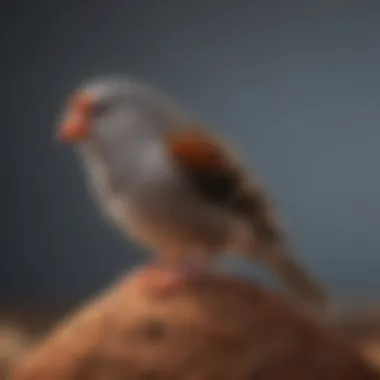
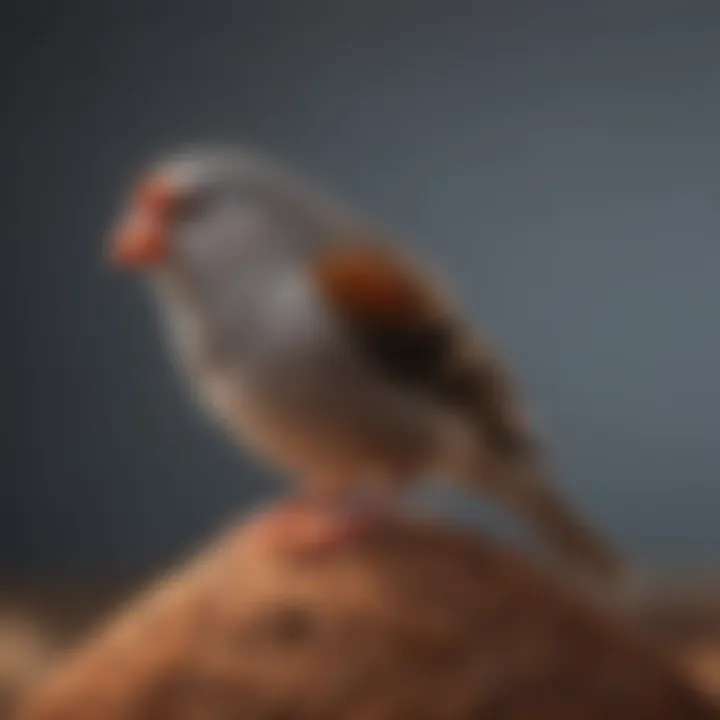
- Hopper Feeders: These allow for easy access of seeds and control food degradation.
- Water Bottles: Provide a steady supply of fresh water and can maintain cleanliness better than dishes.
Monitoring food and water accessibility will support the healthy diet and hydration of these pet birds, promoting overall health and cycles of activity.
“A stimulating environment greatly improves the lives of zebra finches, fundamentally supporting their well-being.”
Integrating well-thought-out accessories can support the nature of zebra finches, enhancing their living conditions dramatically. Bird owners must consider these features to craft an enriching space that accords well with the needs and instincts of the birds.
Maintaining a Healthy Cage Environment
Maintaining a healthy cage environment is essential for the well-being of zebra finches. These birds are sensitive creatures, and their health greatly relies on the conditions of their habitat. Proper maintenance ensures that they thrive, which includes keeping their cage clean and suitable for life. A healthy environment reduces the risk of diseases and improves the birds' overall happiness.
Cleaning and Hygiene Practices
Cleaning is one of the most important aspects of maintaining a cage. Regular cleaning prevents the build-up of waste, mold, and bacteria that can lead to health problems. Daily tasks should include removing uneaten food and leftover seeds from the previous day. It is also crucial to spot-clean any droppings or spilled food. A more thorough weekly cleaning routine entails washing down the bars of the cage, removing perches and toys to scrub them, then cleaning the floor of the cage to ensure hygiene.
Steps for effective cleaning:
- Use mild soap or a bird-safe cleaning solution.
- Rinse all surfaces thoroughly to remove soap residue.
- Ensure that everything is dry before returning items to the cage.
- Replace bedding material regularly for hygiene.
Keeping a cage clean not only improves aesthetics but also affects the birds' health. Regularly cleaned environments lower the chance of respiratory infections and skin conditions.
Monitoring Temperature and Humidity
Temperature and humidity are critical factors that can impact the comfort of zebra finches. Extreme temperatures can lead to stress and health issues. It's important to maintain a stable environment that mimics their natural habitat. Ideally, zebra finches thrive in temperatures between 65 to 80 degrees Fahrenheit with moderate humidity levels.
To monitor conditions, consider using a hygrometer and thermometer in the cage area. Keeping an eye on these metrics provides insight into whether adjustments are needed. If the temperature or humidity fluctuates greatly, it is advisable to adjust air conditioning or heating.
Some tips for maintaining ideal conditions:
- Place the cage in a location free from drafts.
- Use a heating pad or bridges for colder times if necessary, but avoid direct heat.
- Make sure there is plenty of fresh air, but avoid exposing them to wind directly.
In summary, actively monitoring conditions and maintaining cleanliness prevents many common health problems for zebra finches.
Common Cage-Related Health Issues
Understanding the common health problems associated with cage environments is critical for any zebra finch owner. These issues can harm your birds' well-being and, overall, their quality of life. Effective prevention of cage-related health issues can enhance the enjoyment of caring for zebra finches, making it essential for owners to acknowledge potential risks and take daily preventive steps.
Respiratory Problems
Respiratory problems generally arise in non-ideal conditions, fostering a respiratory system that is fragile and sensitive in zebra finches. Dust, mold, and poor ventilation can significantly impact their respiratory health. For example, retention of bird droppings and leftover food can produce mold, which is harmful when inhaled. The initial signs of respiratory complications may include consistent coughing, sneezing, or unusual vocalization patterns.
Precautions should include regular cage cleaning to minimize dust accumulation reinforced with good ventilation systems. Spot cleaning droppings several times a day, instead of waiting for the once a week major clean, will also promote a healthier atmosphere for the zebra finch. Best practices naturally lead to healthier long-living birds.
Behavioral Issues Arising from Poor Environments
Zebra finches are sensitive creatures that thrive on enriching environments. A poorly designed cage, devoid of stimulation, can prompt various behavioral problems. Birds may exhibit signs of frustration or stress, such as repetitive chirping or territorial aggression. When lacking adequate space or enrichment, they may turn to self-destructive behaviors like excessive feather plucking.
Lack of social interaction may also exacerbate these issues, as these birds are social by nature. Following are considerations to ensure a more appealing space:
- Provide stimulation: Include various toys to keep their guides active. Toys allow for exploration and engagement.
- Allocate enough space: Birds require enough room transverse the cage for healthy activity without feeling cramped. Only tigh cages could lead to agitated behavior.
- Integrate social companions: Pairing or groupe the finches provides them the interactions that can deter behavioral issues brought on by loneliness.
Overall consideration towards well-maintained enrichment in the cage can significantly reduce adverse behavioral expressions while ensuring a happy and healthy zebra finch.
Caring for zebra finches is a rewarding journey. Addressing common cage-related health issues through informed practices maintains their health and intensifies the bonding experience.
Closure: Preparing for Zebra Finch Ownership
Zebra finches are delightful companions, and preparing for their ownership is a critical step in ensuring their well-being. The conclusion of this guide serves as a vital reminder that selecting the right cage is only one part of providing a healthy environment for these birds. This section highlights various aspects that potential owners must consider.
Final Thoughts on Cage Selection
When selecting a cage for zebra finches, various factors come into play that significantly impacts their quality of life.
- Size: The enclosure must be spacious, allowing the finches to stretch their wings and move freely. A cramped setting causes stress and can lead to health issues.
- Material: The cage material is also crucial. Metals that are safe and non-toxic, such as stainless steel or powder-coated coated materials, are preferred. Avoid cages made of untreated wood or plastic that may harbor bacteria.
- Design: Features like a removable tray for easy cleanup, ample perches at varying heights, and suitable toys greatly enrich the birds' habitat.
By addressing these elements, owners can create a suitable environment that fosters Zebra finch happiness and health.
Next Steps in Avian Care
Preparing for zebra finch ownership extends beyond selecting the appropriate cage. Following are essential steps to ensure comprehensive avian care:
- Hydration: Always provide fresh water daily. Use a fountain or dish that minimizes contamination.
- Nutrition: Invest in high-quality finch seed mixes, supplemented with fruits and greens. A balanced diet is paramount to their maintenance.
- Vet Visits: Schedule annual check-ups with an avian vet. Like all creatures, zebra finches can suffer from underlying health conditions.
- Socialization: Create social interactions to keep them engaged. Singh along, or even allowing playtime outside the cage can enrich their day.
- Observation: Keep an eye on their behaviors. Any noticeable change might denote stress or a health vow.
Building this retting frame will ensure that zebra finches flourish in a safe and nurturing environment, paving the way for a long and happy life with their human guardians.
Preparing adequately leads to fulfilling and successful ownership with these vibrant birds.















